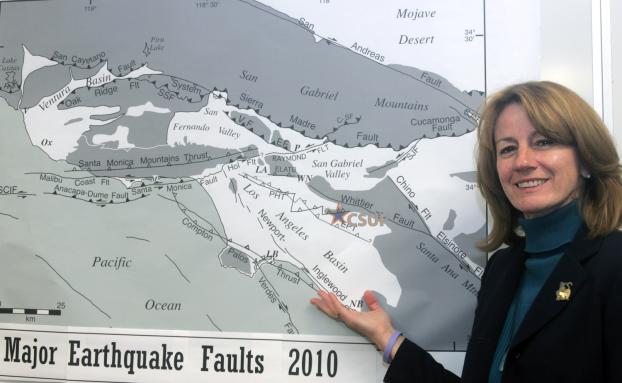 Caption: Campus emergency management coordinator Susan Fisher displays a map of the major earthquake faults in Southern California and where they are in relation to Cal State Fullerton. Photo by Karen TapiaDownload Photo
Caption: Campus emergency management coordinator Susan Fisher displays a map of the major earthquake faults in Southern California and where they are in relation to Cal State Fullerton. Photo by Karen TapiaDownload Photo
Planning for the Worst, Hoping for the Best
Campus Emergency Planner Pushes for Preparedness
The 1994 Northridge earthquake occurred at 4:31 a.m. Jan. 17 — Martin Luther King, Jr. Day. Although the actual quake lasted mere seconds, the magnitude of injuries and damage was astonishing. And the residual effects lasted for more than a year.
That’s why it’s so important to Sue Fisher, emergency management coordinator, that the campus community take part in the Oct. 21 Great California Shakeout. The annual statewide exercise was established in 2008 to help California residents prepare for a major quake.
“It’s especially important for those of us who work on a university campus to be prepared,” said Fisher, who operates as part of University Police. “Aside from the fact that the quake could occur when we are not home to help our families — we are working on a campus that has between 12 and 15,000 students on site daily and another 2,500 faculty and staff members, as well as visitors attending theater, dance or music productions, athletic events or some other special activity. And a major earthquake could bring more people seeking care and shelter.
“I believe that the upcoming statewide exercise is a great opportunity to find out how prepared we are and what can we do to be better prepared.”
Below, Fisher answers questions about how members of the campus community can get ready for the “Big One.”
How can we personally prepare?
It can be a large task and sound very difficult but if we all break down the elements to manageable sizes, the task is not so onerous. That’s why I have been sending out weekly messages — to help us start thinking of the things we can do. The first message was simple — purchase a sturdy plastic bin or metal trash can. This can be stored where it is accessible to you or your family following a quake and inside you can store important materials that will help you survive.
What are the major things we should think about?
With luck, all of us have done certain things already — such as having a case of water in our car — so we need to ask ourselves how prepared we are now and what can we do to be more prepared. All of us have to think about when a quake can occur and what will be things in our lives will be disrupted. Perhaps we are evacuated from our homes and can’t return — what do we need to cope?
If we’re at work, do our family members have an evacuation plan, know how to contact a specific family member who lives out of area as a point of contact? Have we made sure that they are ready to take care of themselves — or have someone who will help them — if we are not there? Most of this is thinking about how we will be able to cope when our normal way of doing things doesn’t work. Planning is key.
What should we be doing as members of the campus community?
Here are some suggestions for campus members related to emergency planning. Some of these come from the CSU video “Academic Aftershocks,” available online.
• Does your department or division have an up-to-date emergency plan? This should be a priority.
• Are faculty members included in emergency training and are they prepared to help students who will look to them for guidance?
• Are faculty, staff and administrators trained in their emergency roles? Do they know where they're supposed to be and what they're supposed to do?
• How will the campus, divisions and departments assess and adapt to continuing problems?
• Is there an adequate system for communications? Do all departments/divisions have telephone trees so they know how to contact one another?
• Are furniture and equipment anchored to the floor?
• Have back-ups or duplicates been made of important documents or research findings? In the event of a disaster that affects the safety of buildings, campus members may not be able to enter for several weeks … if not months.
What will be happening during the Great Shakeout?
We actually have a week of events kicking off on Monday, Oct. 18, with an earthquake simulation by the Engineering Department. (See sidebar for details of what will be happening on campus).
What is your major goal for the Great California Shakeout?
My message is that this is a great opportunity to test ourselves. There may be some people who will not take part in the duck and cover exercise and the campus-wide evacuation drill — but I hope that the majority of us will use this as a real-learning experience and take it as an opportunity to learn more.
Oct. 12, 2010
